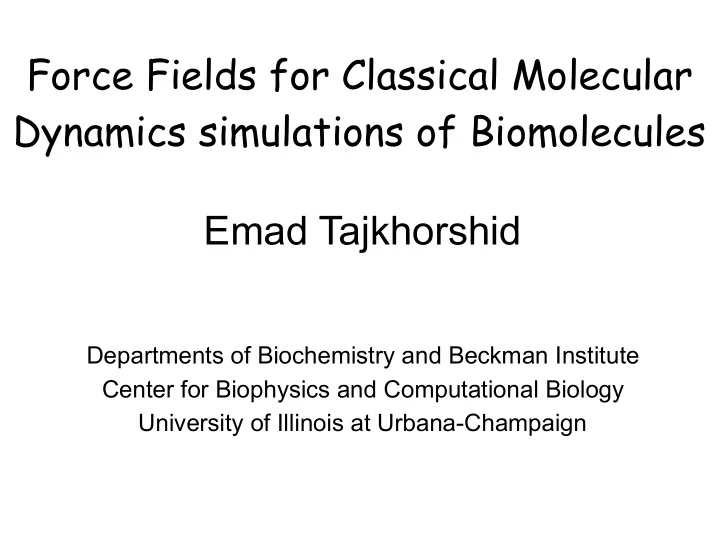

Force Fields for Classical Molecular Dynamics simulations of Biomolecules Emad Tajkhorshid Departments of Biochemistry and Beckman Institute Center for Biophysics and Computational Biology University of Illinois at Urbana-Champaign
Classical Force Field Parameters • Topology and structure files • Parameter files • Where do all the numbers needed by an MD code come from? • Where to find these numbers and how to change them if needed. • How to make topology files for ligands, cofactors, special amino acids, … • How to develop / put together missing parameters.
Classical Molecular Dynamics q q 1 i j U ( r ) = 4 r U ( r ) = ✏ ij [( R min,ij ) 12 − ( R min,ij πε ) 6 ] 0 ij r ij r ij Coulomb interaction
Classical Molecular Dynamics Bond definitions, atom types, atom names, parameters, … .
Energy Terms Described in Bond Angle Dihedral Improper
The Potential Energy Function U bond = oscillations about the equilibrium bond length U angle = oscillations of 3 atoms about an equilibrium bond angle U dihedral = torsional rotation of 4 atoms about a central bond U nonbond = non-bonded energy terms (electrostatics and Lenard-Jones)
Interactions between bonded atoms 2 ( ) V angle = K θ θ − θ o 2 ( ) V bond = K b b − b o V dihedral K ( 1 cos( n )) = + φ − δ φ
2 ( ) V K b b = − bond b o Chemical type K bond b o 100 kcal/mole/Å 2 C-C 1.5 Å 200 kcal/mole/Å 2 C=C 1.3 Å 400 kcal/mole/Å 2 C=C 1.2 Å Bond Energy versus Bond length 400.0000 Potential Energy, kcal/mol 300.0000 200.0000 Single Bond Double Bond Triple Bond 100.0000 0.0000 0.5 1.0 1.5 2.0 2.5 Bond length, Å Bond angles and improper terms have similar quadratic forms, but with softer spring constants. The force constants can be obtained from vibrational analysis of the molecule (experimentally or theoretically).
Dihedral Potential V dihedral K ( 1 cos( n )) = + φ − δ φ Dihedral energy versus dihedral angle 20.0000 Potential Energy, kcal/mol 15.0000 10.0000 K=10, n=1 K=5, n=2 K=2.5, N=3 5.0000 0.0000 0 60 120 180 240 300 360 Dihedral Angle, degrees δ = 0˚
Nonbonded Parameters q i q j + ✏ ij [( R min,ij ) 12 − ( R min,ij X ) 6 ] 4 ⇡ Dr ij r ij r ij non − bonded q i : partial atomic charge D: dielectric constant ε : Lennard-Jones (LJ, vdW) well-depth R min : LJ radius (R min /2 in CHARMM) Combining rules (CHARMM, Amber) R min i,j = R min i + R min j ε i,j = SQRT( ε i * ε j )
Electrostatic Energy versus Distance 100.0000 80.0000 60.0000 40.0000 Interaction energy, kcal/mol 20.0000 0.0000 -20.0000 q1=1, q2=1 q1=-1, q2=1 -40.0000 -60.0000 -80.0000 -100.0000 0.0000 1.0000 2.0000 3.0000 4.0000 5.0000 6.0000 7.0000 8.0000 Distance, Å Note that the effect is long range. From MacKerell
Charge Fitting Strategy CHARMM- Mulliken* AMBER(ESP/RESP) Partial atomic charges -0.5 0.35 0.5 -0.45 C O H N *Modifications based on interactions with TIP3 water
CHARMM Potential Function PDB file Topology PSF file geometry parameters Parameter file
File Format/Structure • The structure of a pdb file • The structure of a psf file • The topology file • The parameter file • Connection to potential energy terms
Looking at File Structures • PDB file • Topology file • PSF file • Parameter file
Parameter Optimization Strategies Check if it has been parameterized by somebody else Literature Google Minimal optimization By analogy (direct transfer of known parameters) Quick, starting point Maximal optimization Time-consuming Requires appropriate experimental and target data Choice based on goal of the calculations Minimal database screening NMR/X-ray structure determination Maximal free energy calculations, mechanistic studies, subtle environmental effects
Getting Started Identify previously parameterized compounds • Access topology information – assign atom types, • connectivity, and charges – annotate changes CHARMM topology (parameter files) NA and lipid force fields have new LJ parameters for the alkanes, representing top_all22_model.inp (par_all22_prot.inp) increased optimization of the protein top_all22_prot.inp (par_all22_prot.inp) alkane parameters. Tests have shown top_all22_sugar.inp (par_all22_sugar.inp) that these are compatible (e.g. in top_all27_lipid.rtf (par_all27_lipid.prm) protein-nucleic acid simulations). For top_all27_na.rtf (par_all27_na.prm) new systems is suggested that the new top_all27_na_lipid.rtf (par_all27_na_lipid.prm) LJ parameters be used. Note that only top_all27_prot_lipid.rtf (par_all27_prot_lipid.prm) the LJ parameters were changed; the top_all27_prot_na.rtf (par_all27_prot_na.prm) internal parameters are identical toph19.inp (param19.inp ) www.pharmacy.umaryland.edu/faculty/amackere/force_fields.htm
Partial Charge Assignment • Most important aspect for ligands • Different force fields might take different philosophies • AMBER: RESP charges at the HF/6-31G level • Overestimation of dipole moments • Easier to set up • CHARMM: Interaction based optimization • TIP3P water representing the environment • Could be very difficult to set up • Conformation dependence of partial charges • Lack of polarization • Try to be consistent within the force field • pKa calculations for titratable residues
Parameterization of unsaturated lipids • All C=C bonds are cis, what does rotation about neighboring single bonds look like? Courtesy of Scott Feller, Wabash College
Dynamics of saturated vs. polyunsaturated lipid chains • sn 1 stearic acid = blue • sn 2 DHA = yellow • 500 ps of dynamics Movie courtesy of Mauricio Carrillo Tripp Courtesy of Scott Feller, Wabash College
Lipid-protein interactions Radial distribution around protein shows distinct layering of acyl chains • • DHA penetrates deeper into the protein surface Courtesy of Scott Feller, Wabash College
Major Recent Developments • New set of lipid force field parameters for CHARMM (CHARMM32 + ) –Pastor, B. Brooks, MacKerell • Polarizable force field –Roux, MacKerell
Recommend
More recommend